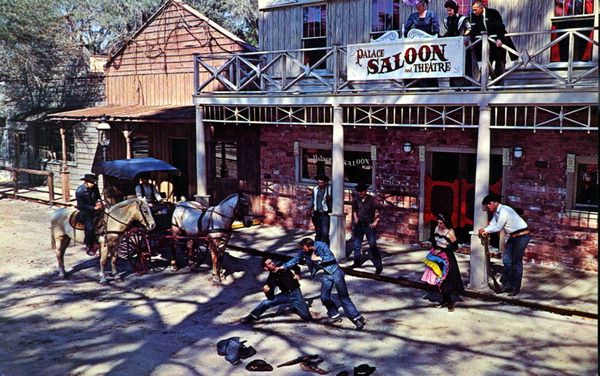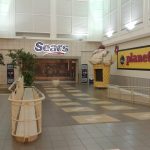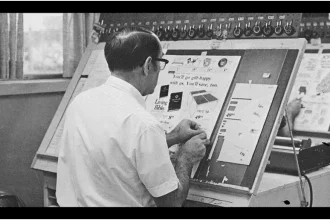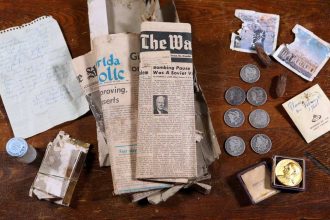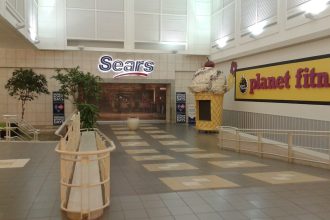Nestled in the pine forests of central Florida, just west of Orlando, Six Gun Territory once stood as a bold homage to the Wild West during the 1960s and 70s. Long before the era of towering roller coasters and digital immersion, this modest theme park offered visitors a taste of frontier life, complete with staged shootouts, saloon skits, and horseback rides through dusty trails. Though the park closed its gates decades ago, its legacy lives on through rare promotional photos, nostalgic memorabilia, and the memories of those who wandered its wooden boardwalks. In this blog post, we dive deep into the history of Six Gun Territory with a curated collection of vintage brochure scans, press photos, a rare audio clip of the park’s original radio jingle, and a downloadable postcard set. We’ll also explore a compelling question: Could a modern western-themed park still work in today’s entertainment landscape? This article contains approximately 3000 words of rich historical context, visual storytelling, and thoughtful analysis to honor a park that, while lost, should not be forgotten.
Vintage Brochures and Press Photos: A Glimpse into the Past
The 1960s and 70s were a golden age for regional theme parks across America. Amid Florida’s growing reputation as a tourist destination—thanks in large part to the opening of Walt Disney World in 1971—smaller, niche parks like Six Gun Territory attempted to capture a slice of the excitement. These parks often relied on local charm, low admission fees, and family-friendly entertainment to draw crowds. Six Gun Territory, located near Bushnell in Sumter County, was one such venture. Opened in 1963 by a group of local investors, the park was designed to resemble a classic Western town, complete with clapboard buildings, hitching posts, and costumed staff.
The promotional brochures from this era are now rare collector’s items. They feature vibrant illustrations of cowboys, Native Americans, and stagecoaches, often with exaggerated action scenes meant to appeal to children and nostalgic adults alike. One 1968 brochure depicts a shootout in the town square, with sheriffs and outlaws exchanging gunfire beneath a bright blue sky. The tagline reads: “Step into the Wild West—where every day is a showdown!” These brochures were distributed at gas stations, rest stops, and roadside attractions throughout the Southeast, hoping to lure passing motorists off I-75.
Press photos from the park’s heyday offer an even more authentic glimpse into daily operations. In one black-and-white image, a group of children watches wide-eyed as a staged bank robbery unfolds in front of the “Six Gun Saloon.” A man in a black hat and long coat dramatically waves a revolver while a sheriff in a star badge gives chase. Another photo shows a young girl petting a gentle draft horse named “Buck,” part of the park’s petting corral and pony ride attraction. These images, often stamped with news agency logos like UPI or AP, were sent to newspapers to generate publicity and feature stories.
What makes these visuals so compelling today is their authenticity. Unlike modern theme parks with their polished CGI renderings and high-definition marketing campaigns, Six Gun Territory’s promotional materials have a handmade, almost theatrical quality. The costumes are clearly off-the-rack Western wear, the sets are wooden facades, and the actors are local performers with big smiles and genuine enthusiasm. There’s a warmth to these images that reflects a simpler time in American entertainment—one where imagination and community effort could build an entire world from scratch.
Mapping the Lost Frontier: Then vs. Now
Understanding the physical footprint of Six Gun Territory helps contextualize its rise and fall. The park was located at the intersection of State Road 471 and County Road 48, approximately 45 miles north of downtown Orlando. In the 1960s, this area was largely rural, with sparse development and plenty of pine flatwoods ideal for a low-impact theme park. Today, however, the landscape has transformed dramatically. Subdivisions, citrus groves, and commercial developments now dominate the region, erasing much of the frontier atmosphere that once defined the park’s setting.
The map overlay below illustrates the approximate location of Six Gun Territory in relation to modern landmarks. Using historical aerial photos and park blueprints, we’ve reconstructed the layout of the original site. The main entrance led into a dusty plaza with the saloon, general store, and sheriff’s office arranged in a semicircle. Behind the town stood the petting zoo, a small train ride, and a stage for live performances. A nature trail looped around the perimeter, allowing visitors to explore the surrounding forest.
Map Overlay Note: The shaded area represents the estimated boundaries of Six Gun Territory (1963–1984). Today, the land is occupied by private residences and agricultural use. No visible remnants of the park remain, though local historians believe some foundation stones may still lie beneath the underbrush.
Interestingly, the site’s proximity to The Villages—a massive retirement community that began development in the 1980s—may have contributed to the park’s closure. As land values rose and demand for housing increased, maintaining a small, seasonal attraction became economically unviable. The park officially shut down in 1984, and the land was sold off in parcels. While no official memorial marks the location, some former employees and local residents still gather annually for informal reunions near the old entrance.
The contrast between then and now underscores a broader trend in Florida’s development. What was once open space for imagination and play has been replaced by functional, profit-driven land use. Yet, for a brief moment, this patch of wilderness hosted a living theater of the American West—a place where children could believe in sheriffs and outlaws, and adults could relive stories from old John Wayne films.
Listen to the Past: The Six Gun Territory Radio Jingle
One of the most evocative artifacts from Six Gun Territory is its original radio jingle. Broadcast on local AM stations throughout the 1970s, the 30-second tune played during morning drive time and weekend specials, inviting families to “saddle up” for a day of frontier fun. The jingle features a jaunty harmonica melody, rhythmic hoofbeat percussion, and a cheerful male vocalist singing:
“Ride into Six Gun Territory, where the fun’s always high!
See the shootouts, ride the ponies, wave to cowboys passing by!
From the saloon to the corral, there’s adventure everywhere—
Six Gun Territory welcomes you with a Western cheer!”
The audio clip below lets you experience this nostalgic piece of marketing history. Though the recording is slightly degraded—evident in the tape hiss and occasional warble—it retains a lively, infectious energy. You can almost picture the station wagon pulling off the highway, kids bouncing in the back seat, eager to explore a town where the Wild West never ended.
Radio advertising was a crucial tool for regional parks like Six Gun Territory. Without the national reach of Disney or Universal, these attractions depended on local media to build awareness. The jingle’s simplicity and repetition made it memorable, and its Western instrumentation reinforced the park’s theme. Today, such a tune might seem quaint or even clichéd, but in its time, it captured the spirit of accessible, low-cost family entertainment that defined mid-century America.
Collectible Memories: Downloadable Postcard Set
To honor the legacy of Six Gun Territory, we’ve created a downloadable set of four vintage-style postcards. Each 4×6 inch card features a high-resolution scan of an original promotional photo or brochure illustration, digitally restored for clarity and color balance. These postcards are perfect for collectors, educators, or anyone who appreciates Florida’s forgotten tourist attractions.
The set includes:
- Postcard 1: The 1967 park entrance, with a stagecoach and costumed greeters.
- Postcard 2: A nighttime shootout scene, lit by kerosene lamps.
- Postcard 3: The petting zoo with children feeding goats and donkeys.
- Postcard 4: A panoramic view of the Western town, used in travel brochures.
These postcards are free to download and share under a Creative Commons license (CC BY-NC 4.0), meaning you can use them for personal or educational purposes, but not for commercial resale. We encourage schools, historical societies, and retro tourism blogs to incorporate them into exhibits or presentations about Florida’s cultural history.
Could a Modern Western Park Still Work?
This brings us to the central question: Would a modern western-themed park succeed in today’s entertainment market? On the surface, the answer seems uncertain. The popularity of Western films and TV shows has waned since the genre’s mid-20th century peak. Contemporary audiences are more drawn to superhero franchises, sci-fi epics, and immersive digital experiences than to tales of cowboys and cattle drives. Moreover, the romanticized portrayal of the American West has come under scrutiny for erasing Indigenous perspectives and glorifying colonial expansion.
Yet, there are compelling reasons to believe a reimagined Western park could still find an audience. First, nostalgia remains a powerful force. Millennials and Gen Xers who grew up watching reruns of Gunsmoke or visiting parks like Knott’s Berry Farm’s Ghost Town may welcome a chance to relive those memories with their own children. A well-designed park could blend historical education with entertainment, offering exhibits on Native American cultures, cowboy life, and the complex legacy of westward expansion.
Second, experiential tourism is on the rise. Travelers increasingly seek authentic, hands-on experiences over passive observation. A modern Western park could offer horseback trail rides, blacksmithing workshops, frontier cooking demos, and interactive storytelling sessions. Imagine a “Junior Ranger” program where kids earn badges by learning survival skills, identifying animal tracks, or participating in a historically accurate reenactment.
Third, location matters. While Orlando is saturated with theme parks, other parts of the country—particularly the American Southwest—could support a Western attraction. New Mexico, Arizona, or Texas might embrace a park that celebrates regional heritage while boosting local tourism. Such a park wouldn’t need to compete with Disney; instead, it could serve as a cultural destination, much like Colonial Williamsburg or Plimoth Patuxet.
Crucially, any new Western park must address historical sensitivity. Rather than perpetuating outdated myths, it should present a balanced narrative that includes the voices of Native peoples, Hispanic settlers, African American cowboys, and Chinese railroad workers. Educational signage, guest speakers, and partnerships with tribal nations could ensure the park respects the full scope of Western history.
In this light, Six Gun Territory wasn’t just a relic of the past—it was a prototype for something that could evolve. Its simplicity, charm, and focus on live performance offer lessons for modern creators. A new Western park wouldn’t need roller coasters or augmented reality to succeed. It would need authenticity, respect, and a commitment to storytelling that honors both the myths and the truths of the American frontier.
In conclusion, while Six Gun Territory may be gone, its spirit endures. Through these photos, maps, sounds, and reflections, we keep its memory alive. And who knows? Perhaps one day, a new generation will rediscover the appeal of ten-gallon hats, wooden sidewalks, and the timeless call of the open range.

